-
🔗 Canada’s 84-year radio time check has stopped because of accuracy concerns
Interesting article about how Canada broadcasted timing information via radio. Reminds me of the 6 pips played just before the news on ABC radio when I was a kid. I’m guessing they served a similar role.
-
Rehearsal today. Haven’t got the PA equipment yet so I had to settle for 30 year old PC speakers. They worked better than expected, but they’ll probably struggle with a full garden.

-
More work on Mainboard Mayhem today. Had a bit more success getting the Windows build into a releasable state.
First thing was the app icon. That blog post I talked about yesterday worked: I was able to set the icon of the executable. I did make a slight adjustment though. The post suggested using ImageMagick to produce the ICO file, but I wasn’t happy with how they looked. There were a lot of artefacts on the smaller icon sizes.
So I looked around for an alternative, and found this package by Lea Anthony. He’s the maintainer of Wails, a cross-platform toolkit for making browser-based GUI apps in Go, sort of like Electron but without bundling Chrome. In fact, most of the build for Mainboard Mayhem was put together by reading the Wails source code, so I trust he knows what his doing. And sure enough, his package produced a nicely scaled ICO file from a source PNG image. Better yet, it was distributed as a Go package, so I could no need to install and shell-out to run it: I could just integrated it directly into the project’s build tool.
Using rsrc to generate the SYSO file with the icon worked as expected: Go did pick it up and embed it into the executable. I did have some trouble getting the Go compiler to pick up these files at first. In short, they need to be in the same directory as the
mainpackage. So if you’re runninggo build ./cmd/thing, make sure the SYSO files are in./cmd/thing. Other than that, no real issues here.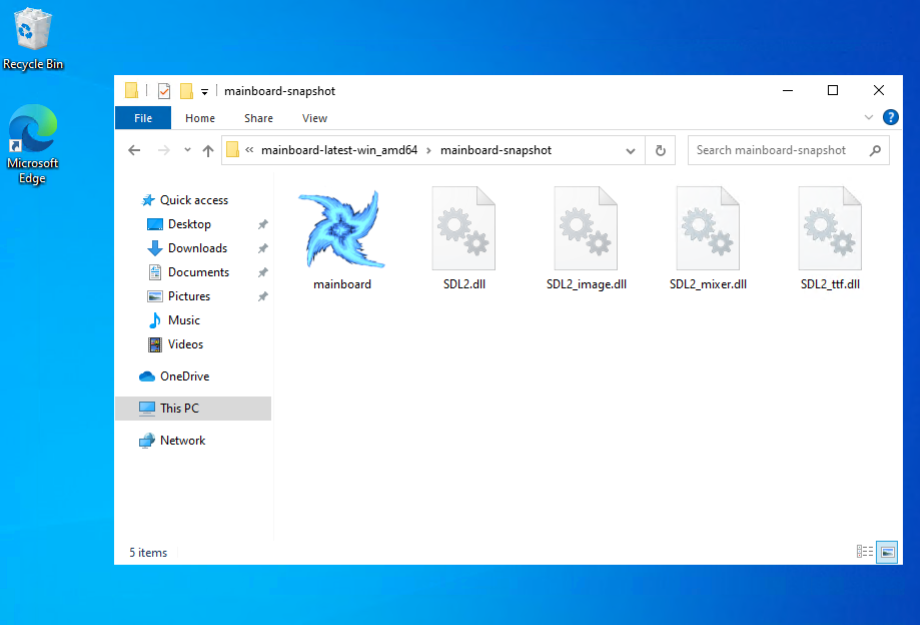
A beautiful site: Mainboard.exe with the embedded app icon One last thing I had to deal with was the console window. Running a Go app in Windows shows the console by default. Perfectly fine for command line tools, but less so for games:
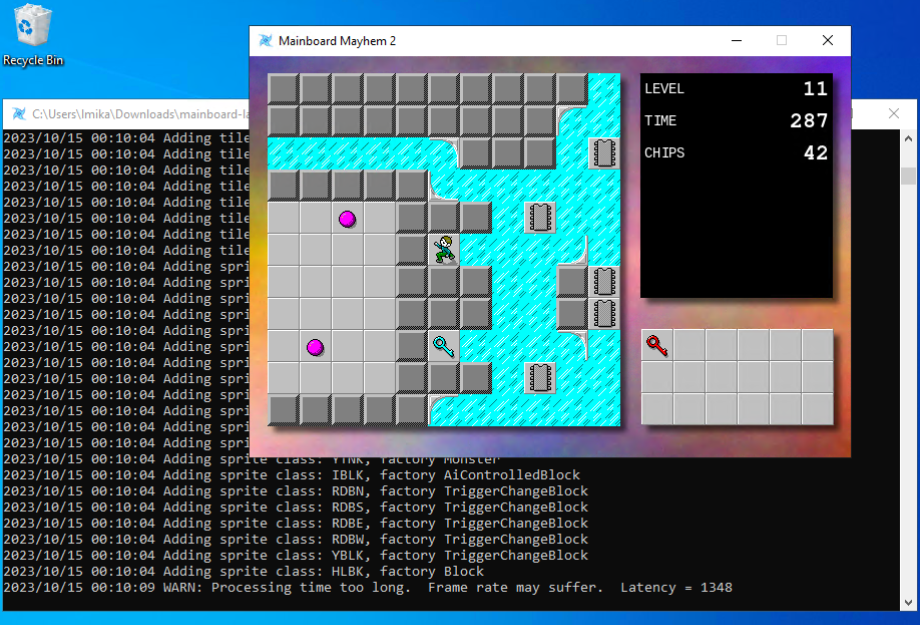
Mainboard Mayhem with that annoying console window. Even the log messages are dull (well, unless you're working on the app). So I had to find a way to hide the console on launch. Since Mainboard Mayhem is using SDL, I’m actually using MinGW to cross-compile the Windows release on an Ubuntu build runner. The documentation for MinGW suggests adding
-mwindowsas a linker option to hide the console:# What I was doing before, which didn't work CGO_ENABLED=1 \ CC="x86_64-w64-mingw32-gcc" \ GOOS="windows" \ CGO_LDFLAGS="-mwindows -L…" \ go build -o dist/cclm/mainboard.exe ./cmd/cclm'This didn’t actually work when I tried it: launching the app kept bringing up the console. Turns out what I should’ve done was follow the advice of many Stack Overflow answers, and set
-ldflags "-H=windowsgui"on the Go command:# This works CGO_ENABLED=1 \ CC="x86_64-w64-mingw32-gcc" \ GOOS="windows" \ CGO_LDFLAGS="-L…" \ go build -ldflags "-H=windowsgui" -o dist/cclm/mainboard.exe ./cmd/cclm'This works even without the
-mwindowsswitch. Not completely sure why though. I guess MinGW is not actually being used for linking? Or maybe-monly works with C header files? Don’t know. 🤷 But doesn’t matter: the console no longer shows up on launch.
Mainboard Mayhem without the console window. A much nicer experience now. Finally, there was testing it all, and for this I just bit the bullet and set-up a Windows 10 virtual machine in Azure. The rate is something like $0.16 AUD an hour, an easy decision compared to spending time trying to get a VM with Windows 10 running on my machine.
One remaining thing that’s slightly annoying is Windows Defender refusing to launch it after download, doing effectively the same thing as Gatekeeper on MacOS does:

Gatekeeper a.la. Microsoft. I’m sure there’s a way around it but it’s probably not worth learning about it at this stage. It’s easy enough to dismiss: click “More Info” and the click “Run Anyway”:
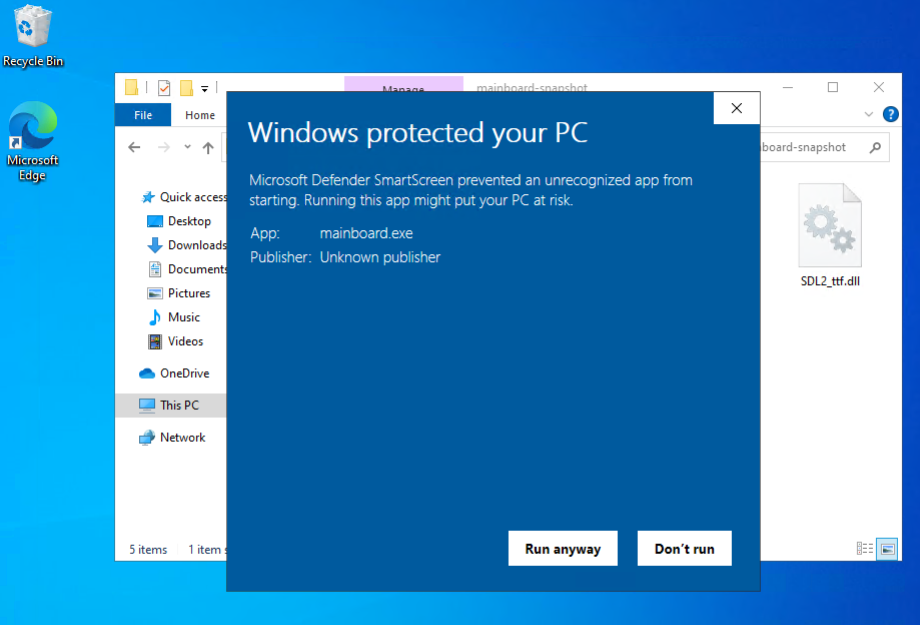
Clicking 'More Info' gives you a way to launch the app. But other than that, I think the Windows version of Mainboard Mayhem is ready. I’ve updated the website to include the Windows archive if anyone’s interested.
-
Spent some time today on Mainboard Mayhem, trying to finish the Windows build. I’ve actually got Windows version of the game being built for a while now. I just haven’t published them, mainly because I haven’t got the app icon set-up yet.
But this week, Golang Weekly had a link to a blog post by Mahmud Ridwan on how to do so. It looked pretty straightforward, so I thought I’d give it a try.
And yeah, the instructions themselves were easy enough, and I wish I could say if they worked or not. But in order to test it, I need a Windows machine. And I don’t have one, and I wasn’t about to get one just for this.
So I tried setting up Windows in a VM using UTM. I got this far:
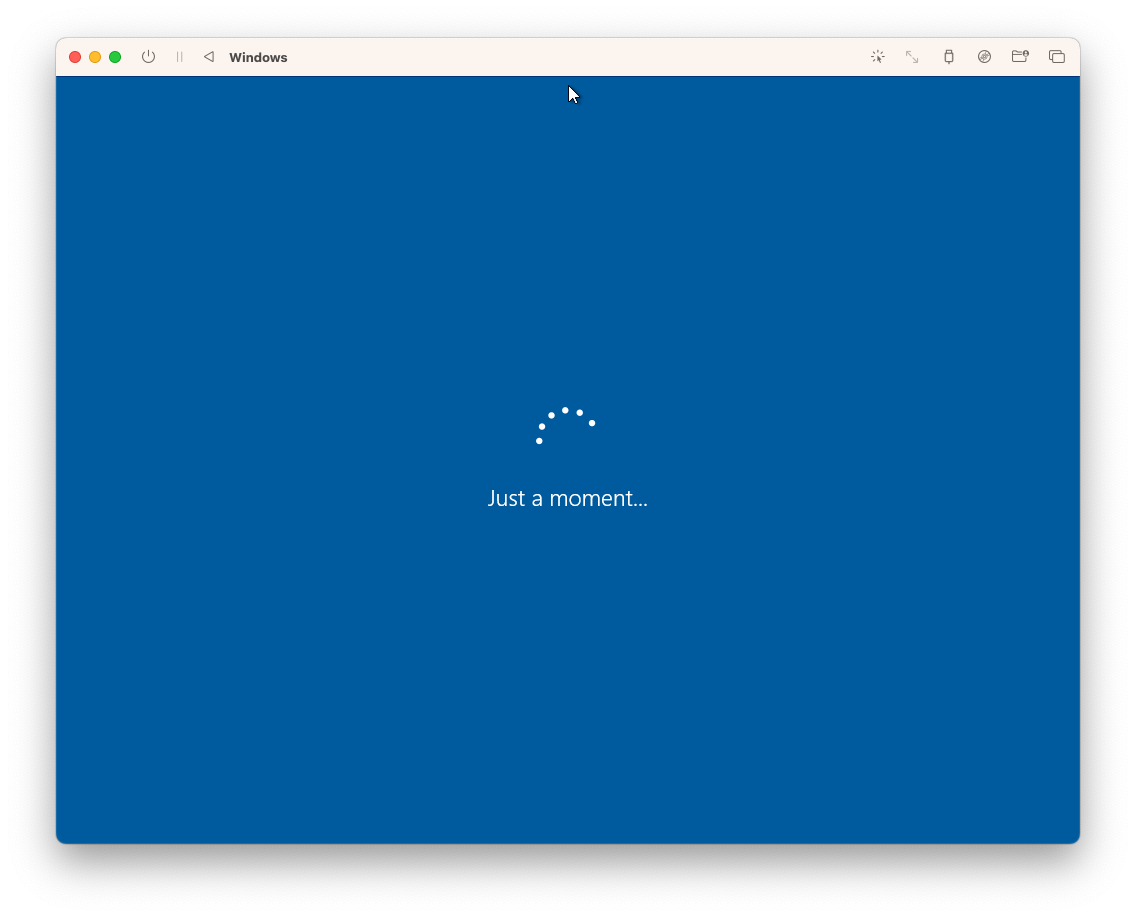
Yeah, this infinite spinner has been staring at me pretty much all day. I got a Windows 10 installer ISO using CrystalFetch, and it seemed to work. But it just doesn’t want to boot up for the first time.
Not actually sure what the problem is. The error message seems to suggest that it’s having trouble connecting to the internet. Might be that? Or maybe the installation didn’t complete properly? Could be anything. 🤷
So no luck getting this tested yet. I’m wondering if it might be easier to forget virtualisation and just launch a Windows instance in the cloud somewhere instead.
-
One way to think about age – we become old when we think and talk more about the past than the future.
Oooh. I feel a little seen. 🫣
-
Installed the latest version of Android today. One obvious change: the calculator app displays fractions in the result. And there’s no way to turn it off.
This… doesn’t appeal to me. Not enough for me to change apps, at least not yet. But I wish there was a setting to change it back to decimals.
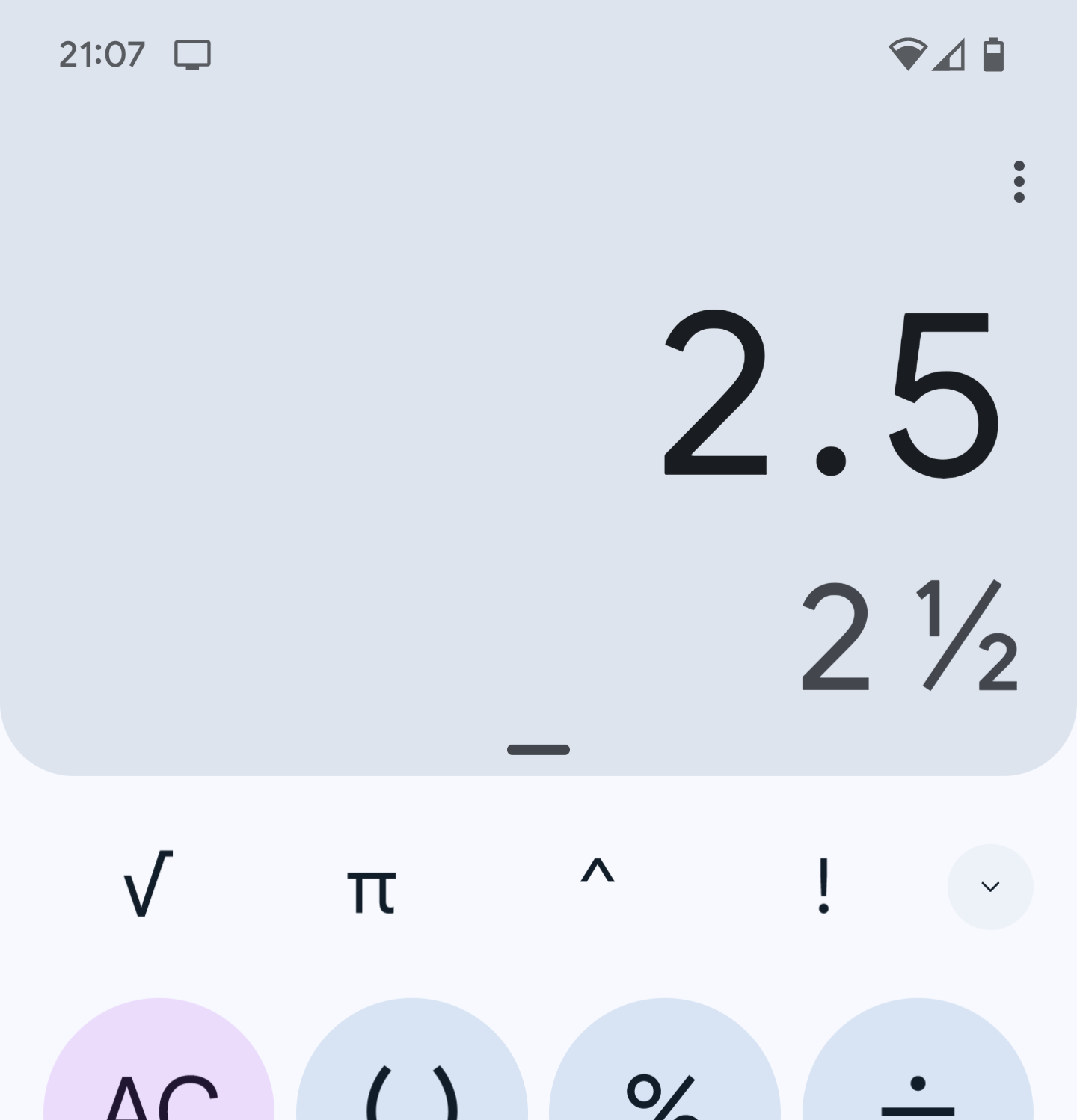
-
Went to Castlemaine for a funeral this morning. For most of my life we would regularly go to Castlemaine to visit family. After today, it might be a while before I visit that town again.
-
Spending my free time adding photos to my travel journal and I’m starting to wonder if less is more. Maybe not having tens of photos crammed into a single entry, and only having a few good ones makes for a better entry overall.
-
🔗 Using Web Components on My Icon Galleries Websites
Lot of neat stuff referenced in this post, like htmx and web components. I’d like to try them in some capacity, like some small web project. Unfortunately, the only things I can think of building right now are things for my job.
-
I use to write up design documents directly in Confluence, as we use that as our knowledge base, but recently I’ve started drafting them in Obsidian. And it’s wonderful. So little friction with getting my thoughts down, especially when it comes to diagrams. Builtin support for Mermaid.js is great.
-
Launched Logic Pro and did some MIDI recording this evening. Here’s an except from “Top of the Morning” from Tubular Bells 3.
-
Yes, PA equipment organised: two speakers, a mixer, and cables. I’ll have to drive to Windsor to pick it up, which is a bit of a hike for me, but I’m glad that’s sorted now.
-
Goland updated to the latest, and the issue I was having with the debugger last week has been resolved. Curious how upgrading to Go 1.21 seems to freak an old version of Goland out when you hit a breakpoint. Would’ve have though that would be fine. But no matter, it’s all working again.
-
All aboard the Goland upgrade train. Calling at 2022.1.4, 2022.2.28, 2023.1.45…
-
If I can recommend one thing anyone with a PA hire service should do, it’s to have specifics of the equipment you offer for hire up on your website. Photos (front and back), size, whether it’s suitable for outdoors, etc. All this would be super useful for someone working out what they’ll need.
-
Been out all morning trying to find someone that does PA hire. Drove to three different locations I found on Google Maps. Two of them are no longer there, and one is only selling consumer audio instead. Now trying someone that does PA hire from their home. Good thing is that they’re close.
-
Looks like the Go debugger has already checked out for the week. I’m trying to debug this unit test and it’s refusing to start the app. It’s just showing me an eternal spinner.
-
Pixel Phones Are Not Dog-food, and That's a Problem
John Gruber on the Pixel 8 launch event: It’s also impossible not to comment on just how much less interest there is in Google’s Pixel ecosystem. […] On the one hand I’m tempted to say the difference is just commensurate with how much better at hardware Apple is than Google. But I think there’s more to it than that. There’s something ineffable about it. There are aspects of marketshare traction — in any market — that can’t be explained by side-by-side product comparisons alone. Continue reading →
-
I’m shutting down Untraveller. I can’t resolve the tension of wanting a comprehensive, but really dry, account of a trip, vs. making it interesting for others to read. I think a Day One journal is more suitable for this.
May keep the domain though. One of the rare ones that worked off the bat.
-
Vivaldi occasionally lockups when I bring up the context menu. I think it happens when it tries to makes a network request for the search icon.

I can remove the menu item if I wanted to, but I’d like to keep it around as I do find it useful. It would be nice to turn the icon off though.
-
Had to go to the new office today so I tried out the commute. The walk from Southern Cross to the office is exactly 20 minutes.
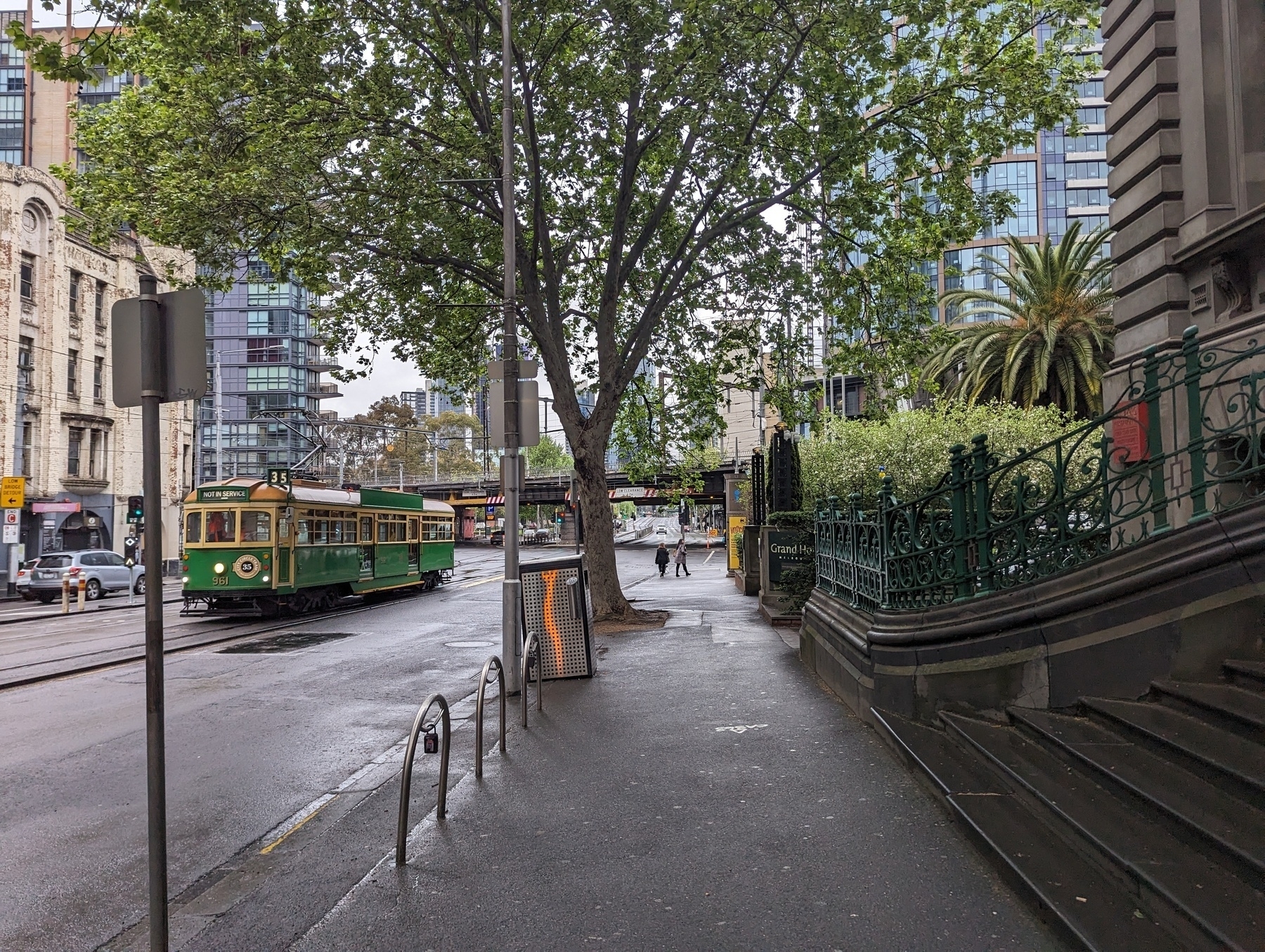
-
Organising travel documents for an upcoming work trip. I used to rely on Google Inbox for this. The way it ingested your itinerary and hotel booking was useful, but the thing I miss the most were the high quality banner images of your destination. Really nice touch.
-
Your Dev Environment is Not Your Production Environment
There will be certain things you’re going to need to do in your development environments that you should never do in production. That’s pretty much a given: playing around with user’s data or potentially doing something that will cause an incident is generally not a good idea. But there are things you shouldn’t do in prod that you may need to do in dev. And make no mistake, there may be a legitimate need to do these things. Continue reading →
-
It’s so much easier to post about how something others have worked on could be made better than it is to write about what I’ve been working on. I think there’s room for both on this blog, but I feel the balance is too many posts on the former and not enough on the latter. I’ll try to do better here.
-
Don’t want to turn this into the “look at what’s wrong with Atlassian’s software” blog, but I found another thing that annoys me about Confluence:

Clicking on a status label brings up a picker, giving you options to change the colour, etc. The picker appears below the label, which usually means it blocks the next thing I want to modify, like the status label in the row below. I need to dismiss the picker first before I can select the label I want to change next.
It’d probably be better if the picker appeared above the label instead.
This is also an issue with dates and links to Jira tickets as well, although with Jira tickets you’re required to make edits within a modal.